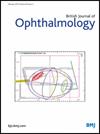Topical β-blockers for treatment of glaucoma and the risk of Parkinson's disease.
IF 3.5
2区 医学
Q1 OPHTHALMOLOGY
引用次数: 0
Abstract
BACKGROUND/AIMS Reports have suggested that treatment with systemic β-adrenoceptor antagonists (β-blockers) may increase the risk of developing Parkinson's disease (PD). The objective of this study was to assess the association between the use of topical β-blockers and PD. METHODS A retrospective cohort study. All newly diagnosed glaucoma patients between 2000 and 2020 were recruited from the anonymised electronic medical records of a large healthcare provider. Patients were followed until December 2021 for the occurrence of PD. The patients were divided into two groups according to topical β-blocker use. Cox proportional-hazards models were used, and HRs with 95% CIs were calculated. RESULTS The cohort included 13 381 glaucoma patients, of whom 10 075 used topical β-blockers (βB group) and 3306 did not (no-βB group). Demographic characteristics were similar between groups. Mean follow-up time and mean number of filled prescriptions for anti-glaucoma medication (total and annually) were significantly greater in the βB group (p<0.0001). During follow-up, 175 patients (1.31%) were diagnosed with PD, 145 in the βB group and 30 in the no-βB group. The HR for PD among topical β-blocker users compared with non-users was 1.16 (95% CI 0.78 to 1.72, p=0.47). Kaplan-Meier analysis showed no significant difference in PD-free survival between the groups (p=0.47). CONCLUSIONS Topical β-blocker use was not associated with an increased risk of PD. These findings suggest that topical β-blockers are a safe therapeutic option, even for patients at potential risk for PD.局部β受体阻滞剂治疗青光眼和帕金森病的风险。
背景/目的有报道表明,全身性β-肾上腺素能受体拮抗剂(β-阻滞剂)治疗可能会增加患帕金森病(PD)的风险。本研究的目的是评估外用β受体阻滞剂与帕金森病之间的关系。方法回顾性队列研究。所有2000年至2020年间新诊断的青光眼患者都是从一家大型医疗保健提供商的匿名电子病历中招募的。随访患者至2021年12月,观察PD的发生情况。根据局部β受体阻滞剂的使用情况将患者分为两组。采用Cox比例风险模型,计算ci为95%的hr。结果纳入13381例青光眼患者,其中10075例使用外用β受体阻滞剂(βB组),3306例未使用(未使用βB组)。组间人口统计学特征相似。βB组的平均随访时间和抗青光眼药物处方的平均配药次数(总配药次数和年配药次数)显著高于对照组(p<0.0001)。随访期间,175例(1.31%)患者被诊断为PD,其中βB组145例,无βB组30例。局部β受体阻滞剂使用者与非使用者相比,PD的HR为1.16 (95% CI 0.78 ~ 1.72, p=0.47)。Kaplan-Meier分析显示,两组无pd生存期无显著差异(p=0.47)。结论β受体阻滞剂的临床应用与PD风险增加无关。这些发现表明,局部β受体阻滞剂是一种安全的治疗选择,即使对有PD潜在风险的患者也是如此。
本文章由计算机程序翻译,如有差异,请以英文原文为准。
求助全文
约1分钟内获得全文
求助全文
来源期刊
CiteScore
10.30
自引率
2.40%
发文量
213
审稿时长
3-6 weeks
期刊介绍:
The British Journal of Ophthalmology (BJO) is an international peer-reviewed journal for ophthalmologists and visual science specialists. BJO publishes clinical investigations, clinical observations, and clinically relevant laboratory investigations related to ophthalmology. It also provides major reviews and also publishes manuscripts covering regional issues in a global context.

 求助内容:
求助内容: 应助结果提醒方式:
应助结果提醒方式:


